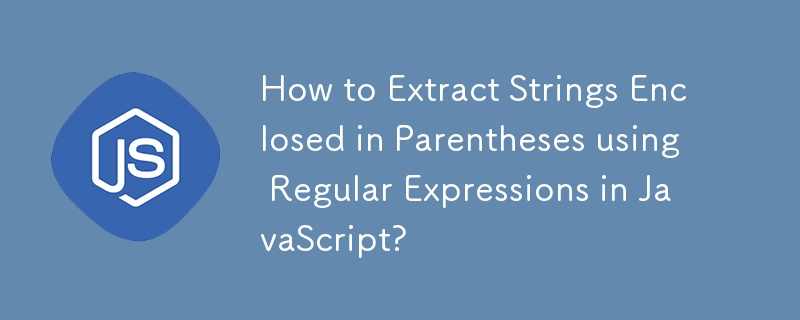Home >Web Front-end >JS Tutorial >How to Extract Strings Enclosed in Parentheses using Regular Expressions in JavaScript?
How to Extract Strings Enclosed in Parentheses using Regular Expressions in JavaScript?
- Mary-Kate OlsenOriginal
- 2024-11-12 06:39:01829browse

Regular Expression to Extract Strings Enclosed in Parentheses in JavaScript
Getting a substring between parentheses in JavaScript using regular expressions can be achieved by constructing a pattern with escaped parentheses (( and )) to match the literal characters and regular parentheses () to create a capturing group. Here's a detailed explanation:
- Create a set of escaped parentheses: Use the backslash () to escape the parentheses characters, ensuring they match the actual parentheses in the text.
- Create a capturing group: Within the escaped parentheses, specify the content to be matched using regular parentheses. This group captures the substring you want to retrieve.
- Construct the regular expression: Combine the escaped parentheses and capturing group into a single regular expression, as shown in the example code provided in the answer:
var regExp = /\(([^)]+)\)/;
In this pattern, (( and ) match the parentheses characters exactly, while the capturing group (1 ) matches any character that is not a closing parenthesis.
- Execute the regular expression: Use the exec() method to apply the regular expression to the input string. The result of the execution is stored in an array, where the first element (matches[0]) represents the entire match, and matches[1] contains the captured substring.
- Access the captured substring: The desired substring can be accessed by retrieving the contents of matches[1].
This technique allows you to efficiently extract the content within parentheses from JavaScript strings using regular expressions.
- ) ↩
The above is the detailed content of How to Extract Strings Enclosed in Parentheses using Regular Expressions in JavaScript?. For more information, please follow other related articles on the PHP Chinese website!
Related articles
See more- An in-depth analysis of the Bootstrap list group component
- Detailed explanation of JavaScript function currying
- Complete example of JS password generation and strength detection (with demo source code download)
- Angularjs integrates WeChat UI (weui)
- How to quickly switch between Traditional Chinese and Simplified Chinese with JavaScript and the trick for websites to support switching between Simplified and Traditional Chinese_javascript skills

